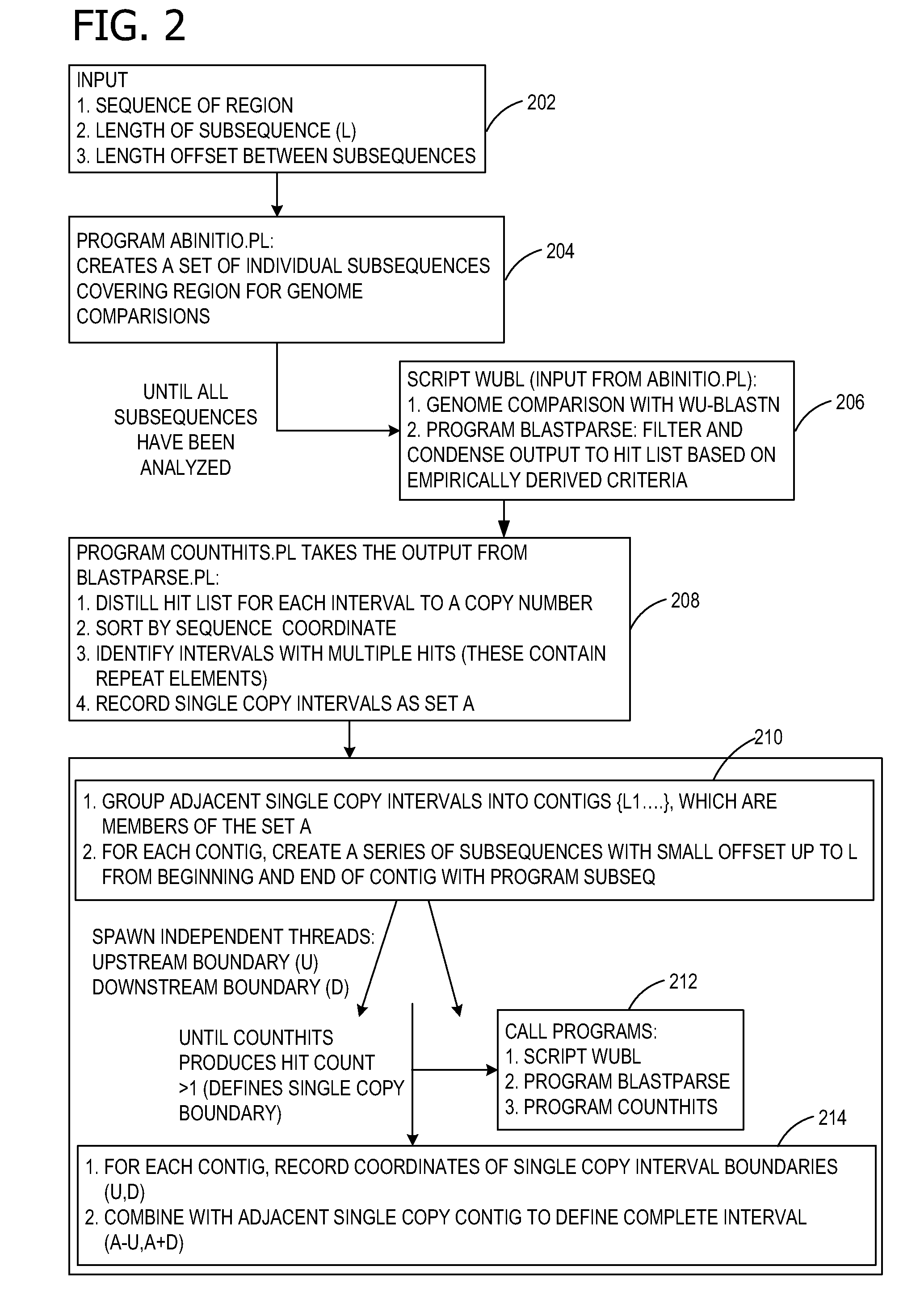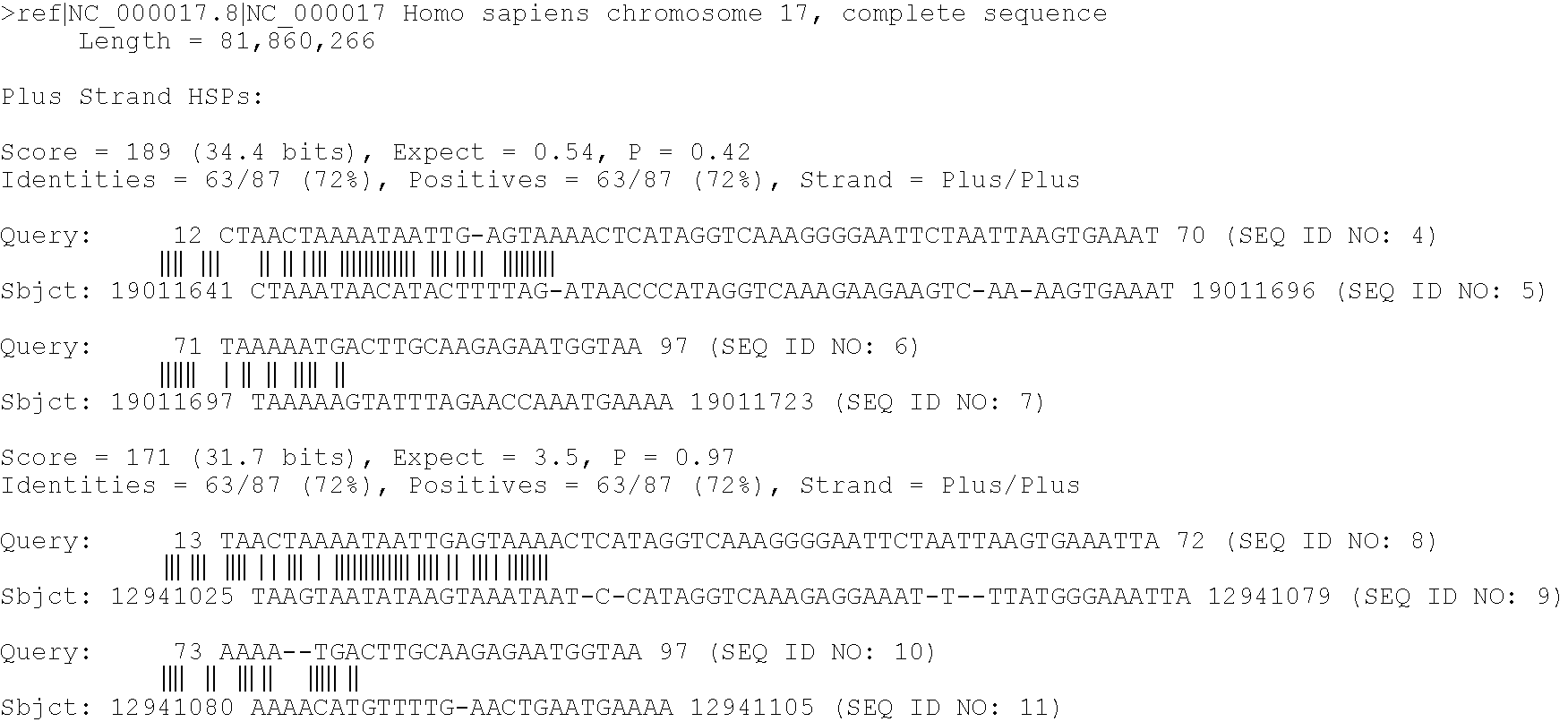Ab initio generation of single copy genomic probes
a single-copy, genomic technology, applied in the direction of instruments, organic chemistry, sugar derivatives, etc., can solve the problems of adverse effects on microarray studies, specificity adversely affecting the utility of probes in diagnosing diseases, and enhanced non-specific hybridization between probes and genomic targets
- Summary
- Abstract
- Description
- Claims
- Application Information
AI Technical Summary
Benefits of technology
Problems solved by technology
Method used
Image
Examples
example 1
[0070]The following example illustrates how the probes designed using the instant invention produce similar results to the repeat-free probes described in U.S. Pat. No. 6,828,097. Here we rederive the single copy intervals shown in Example 1 of that patent with the present invention. First we determined the locations of the repetitive sequences in the human HIRA gene and flanking regions (SEQ ID NO: 1) and subsequently inferred the locations of the single copy intervals therefrom.
TABLE 1Results obtained using the method described in U.S. Pat. No. 6,828,097POSITION INPOSITION IN REPEATREFERENCECONSENSUSSEQUENCEREPEATSEQUENCE*Begin CoordEnd CoordFAMILYBegin Coord End Coord633653GC_rich121695859(CCG)n31729871008GC_rich1226471061MLT2A1436129133014MER58B23934030533397L1M42884320933983698AluJb303236993935L1M43209345140024465L1M4c1469100344664766AluY300147674861L1M4c100491048655081AluJo522050825137AluSq / x8614151385211AluS76252145713L1MEc2392187657406031AluSx295660776206L15015487962916557L1...
example 2
HIRA Gene
[0090]The same approximate 103 kilobase pair length interval comprising the 100,836 by HIRA gene and flanking sequences (SEQ ID NO: 1) was extracted from Genbank accession NT—001039. Position 1 of this interval corresponds to position 798,334 of NT—001039. This approximate 103 kb interval was analyzed using the method of the instant invention. The following indicates a comparison of results obtained for design of single copy probes using the method of U.S. Pat. No. 6,828,097 versus the ab initio method of the instant invention. The coordinates provided correspond to the 103 kb interval from which probes were previously derived.
[0091]Unless otherwise noted, initially the sequence region to be tested for repetitive and single copy sequences was separated into consecutive 1000 by intervals, each of which were tested for similarity for other sequences in the genome using WU-BLAST as described in Example 1. These were divided into 100 nucleotide (nt) intervals usually overlappin...
PUM
| Property | Measurement | Unit |
|---|---|---|
| length | aaaaa | aaaaa |
| reiteration frequency | aaaaa | aaaaa |
| nucleic acid hybridization | aaaaa | aaaaa |
Abstract
Description
Claims
Application Information
 Login to View More
Login to View More - R&D
- Intellectual Property
- Life Sciences
- Materials
- Tech Scout
- Unparalleled Data Quality
- Higher Quality Content
- 60% Fewer Hallucinations
Browse by: Latest US Patents, China's latest patents, Technical Efficacy Thesaurus, Application Domain, Technology Topic, Popular Technical Reports.
© 2025 PatSnap. All rights reserved.Legal|Privacy policy|Modern Slavery Act Transparency Statement|Sitemap|About US| Contact US: help@patsnap.com



